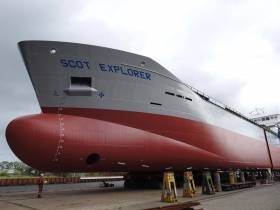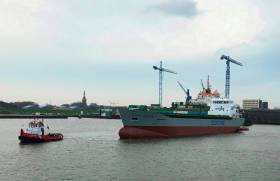Displaying items by tag: Forest products
Second of Three Ship Order Launched for UK Forest Products Operator Which Serves Irish Ports
Scot Explorer became the latest launch for a UK shipping forests products operator, following a christening ceremony that was held at a Dutch shipyard yesterday, writes Jehan Ashmore.
The launch (footage) of newbuild (NB 747) at the Royal Bodewes yard in Hoogezand marked the second of a three-ship order confirmed from Scotline which has its headquarters based in Romford, Kent.
Unlike leadship Scot Carrier launched last year, the latest newbuild of the trio of 4,800dwt sisters, differs having enclosed bridge wings, in order to make manoeuvring easier. The newbuild is due to be completed next month.
As for the final timber products carrier, this newbuild to be named Scot Ranger is scheduled to be delivered at the end of 2020.
Scotline primarily runs liner services throughout northern Europe with regular routes between Sweden, Ireland, Denmark, Germany, Norway and the Baltic States. In addition to those serving the UK, Netherlands and France.
Forest Products Carrier Takes to the Seas for First Trials
#Ports&Shipping- Specialist forest carrier operator, ScotLine which operates regular services to Irish ports, last week saw their latest newbuild take to the seas for first trails, writes Jehan Ashmore.
Since Scot Carrier's christening launch ceremony in September, the 4,800dwt short-sea timber trader, now the largest of the fleet has undergone outfitting. Last week the 90m long cargoship which has a beam of 15m departed on a canal journey under towage from the Dutch inland shipyard of Royal Bodewes in Hoogezand to Delfzijl.
From there Scot Carrier sailed under its own propulsion (Mak engine) to Eemshaven having made the passage through the Ems Estuary to enter the open sea. According to Royal Bodewes the inaugural sea trial in the North Sea was successfully executed.
Furthermore, Afloat today tracked Scot Carrier undergoing trials again having departed Emshaven, from where the newbuild is at time of writing offshore of Esbjerg, Denmark.
Scot Carrier has been given an ice class 1B classification which is important for Baltic customers of the operator, which primarily runs 'liner' services around Northern Europe with regular routes between Ireland, Denmark, Sweden, Norway and Germany. In addition to liner links calling to ports in the UK, France and The Netherlands.
The newbuild will join fleetmates that in addition to transporting forest products also can vary in loading a variety of bulk and project cargoes.






























































